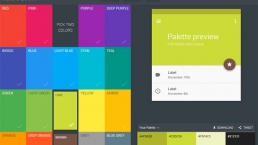
Introduction and features
Adobe has just announced Lightroom CC and Lightroom 6, the latest versions of its professional photo cataloguing and editing software. They’re actually the same program, but Lightroom CC is the version that’s integrated into Adobe’s subscription-based Photography Plan, part of its Creative Cloud service, while Lightroom 6 is the ‘perpetual licence’ version which you pay for and use in the old-fashioned way.
The advantage of Lightroom CC is that you get all the benefits of the Creative Cloud system, including online storage and display and the ability to synchronise collections with mobile devices like phones and tablets.
Lightroom 6 is for folk who don’t like the idea of software subscriptions. The disadvantage here is that you don’t get the Creative Cloud features and when Lightroom 7 comes along you’ll have to pay to upgrade.
What does it do?
Lightroom is Adobe’s professional image cataloguing program and it’s designed to be used alongside a regular image-editor like Photoshop, though as Lightroom’s editing tools get more and more sophisticated, it can often do all the image-editing work you need on its own.


You’ll still need a program like Photoshop for layers, montages, masks and other heavy-duty manipulation, but Lightroom is fine for adjusting exposure, contrast and colours, cloning out sensor spots and unwanted objects, adding graduated filters for skies and radial filters for vignette effects – it even has adjustment brushes for enhancing selected areas of the photo.
Basically, if you need to combine images and make precise collections, you need Photoshop (or some other image-editor), but if you simply want to enhance single photos the Lightroom can almost certainly do it on its own.

Lightroom is not the same as Bridge, Adobe’s folder browsing tool. Bridge is designed to show you the contents of folders on your hard disk in real time and with no centralised database to speed up searches. It’s fine for simple filing systems, but no good if you need to search for images by keyword, camera uses, location and a host of other possible parameters. This is where you need Lightroom. It’s much more powerful and is designed for large image collections, which it can filter, search and organize in seconds, regardless of where the photos are actually stored.
You start by importing photos into the Lightroom library. It can then show you your pictures in a Folder view showing the folders on your computer, but you can also create Collections (and Smart Collections) which are independent of the original folders and can form the basis of a fast, flexible and adaptable filing system for your photos.
Lightroom’s editing tools
Lightroom’s editing tools don’t reach the same depths as Photoshop’s, but that’s because it’s working within the limitations of a non-destructive process. Lightroom’s adjustments simply change the appearance of the picture within the program itself – the original photos remain completely unaltered. To create permanent copies of your adjustments you export your edited images as new JPEG or TIFF files.
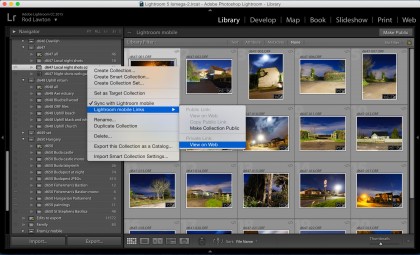

Lightroom’s editing tools are now so powerful, though, that you may not need a separate image editor for most of the things you do. It can adjust exposure, contrast, ‘clarity’, white balance, saturation and more. It has in-built lens correction profiles to counteract distortion and chromatic aberration in lenses, and it has geometric correction tools for fixing perspective issues, like converging verticals in tall buildings.
In particular, it can apply ‘localised’ corrections. You can paint adjustments on to areas of a picture using the Adjustment Brush, darken bright skies with the Graduated Filter tool and create subtle vignette effects with the Radial Filter.
You can even clone out sensor spots, blemishes and even whole objects with the Spot Removal tool, which is much more powerful than the name suggests.
So what’s new?
Adobe has introduced new tools for organizing your photos into Lightroom 6, but the main additions are to the editing tools. There are exciting new panorama and HDR tools, and it’s now possible to ‘brush out’ areas adjusted with the Graduated and Radial filter tools – a really useful enhancement.
Lightroom 6 introduces face-recognition to help organise pictures of people and it comes with new HTML5 web galleries and a major upgrade to the Slideshow tools so that you can now create more movie-like experiences.
We’ll take a closer look at these new features on the following pages.
HDR Merge and Panorama Merge
These two features are brand new in Lightroom 6. Previously, if you wanted to stitch together multiple frames to make a panorama, or combine separate exposures into a single HDR (high dynamic range) image, you would have to send them to Photoshop.
But now, the same Photomerge technology used in Photoshop is built into Lightroom too – for these particular tasks, at least.
HDR Merge in action
HDR (high dynamic range) images can be tricky to get right. It’s easy enough to shoot a series of exposures of the same scene and there are plenty of programs which can merge these into an HDR image – Photoshop is one – but getting results which look realistic or pleasing takes a bit more work.
But Lightroom 6 makes it disarmingly simple by keeping the technicalities to a minimum yet delivering really good results.

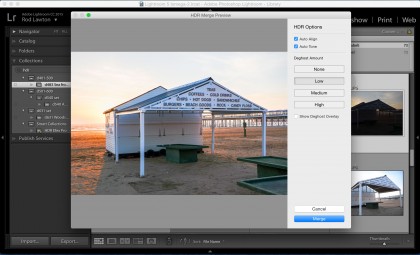

First, you select the images you want to merge and then you choose the Photo Merge > HDR option from the menus and wait while Lightroom creates an HDR preview in a separate HDR Merge window. You can check the Auto Align box to make sure Photoshop adjusts any misalignment between images and the Auto Tone box to automatically correct the contrast and brightness of the result.
There are options too for ‘Deghosting’ the image, but these may only be necessary if you have moving objects moving between the frames, such as leaves and branches, or passers by.
When you hit the Merge button it can take a minute or so to blend the images, and once it’s done it’s clear that Lightroom has done something different and rather good. Instead of creating a lurid, ‘artistic’ HDR image with dramatic tonal contrast and ‘glow’ effects, it produces a very realistic image with all the shadows and highlights intact but without unrealistic tonal compression or flattened contrast.
Panorama Merge in action
The Panorama Merge feature could hardly be simpler. First, you select the individual frames of your panorama in Lightroom, then choose ‘Photo Merge’ and then the ‘Panorama’ option from the menu.
If you’ve done this before in Photoshop you’ll know that you’re then presented with a fairly complex dialog listing different layout options and a list of source files. Here, it’s much simpler. Lightroom offers three different ‘Projections’ – you can think of these as the surface you’re creating the panorama on. You can leave it to ‘Auto Select Projection’ or manually choose ‘Spherical’, ‘Cylindrical’ or ‘Perspective’. A cylindrical projection is usually best for regular single-strip panoramas.
Now you just decide whether you want Lightroom to ‘Auto Crop’ your panorama or not. The stitching process will leave ragged blank areas at the edges of the picture, and while Photoshop has special ‘content-aware’ technology to fill these in, Lightroom does not, so the Auto Crop option will save you having to crop the edges off manually afterwards.
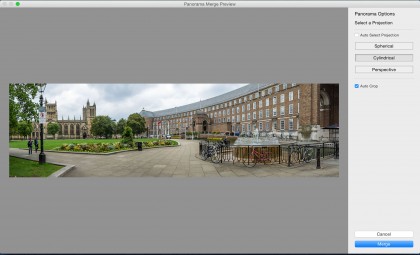
And that’s it. Lightroom will produce a perfectly-stitched panorama with no further effort on your part. It works extremely well, and its a simplified version of the panorama tools in Photoshop, which makes it all the more welcome.
Panoramas don’t always have to be in a super-wide letterbox format, of course. Just two overlapping frames can be stitched together to produce a more normally-proportioned super-wideangle shot.
In a final twist, both the HDR and Panorama tools produce DNG files rather than JPEGs or TIFFs – and this gives much more scope for image manipulation and enhancement later.
Filter masking and brush changes
The secret of Lightroom’s success is the way that it combines powerful image cataloguing features with powerful editing tools. It’s not just a raw converter. As well as adjusting contrast, dynamic range, exposure, white balance and a whole host of other global image properties, it can apply localised adjustments to specific areas of a picture.
Where you might use an adjustment layer and a mask in Photoshop to darken a sky, for example, you can use the Gradient Filter in Lightroom. There’s also a Radial Filter for creating highly controllable vignette effects and subtly ‘relighting’ your pictures and a manual Adjustment Brush for painting over areas you want to modify.
But Lightroom adds two important modifications. First, it’s now possible to manually mask out areas modified by the Gradient and Radial Filters. This is really important because sometimes you’ll have buildings or other objects jutting out into a darkened sky – and you don’t want these objects darkened by the Gradient Filter. It’s a common problem that now has a solution.
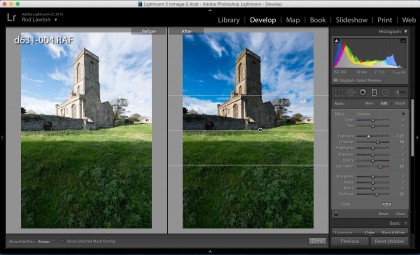


Second, it’s now possible to move the ‘pins’ created by the Adjustment Brush. Previously, these were placed permanently at the point where you started brushing, and the only way to alter the area affected was to brush in new areas or erase areas you wanted left alone – the pins themselves were immovable.
Now you can simply drag the pins to new positions. It doesn’t really change the way the Adjustment Brush works – it doesn’t make anything possible that wasn’t before – but it does make using these brush adjustments simpler, quicker and much more intuitive.
Filter masking in action
The new Filter masking tools are really simple to use because they’re just an extension of the familiar Adjustment Brush tools. Now, when you use the Gradient Filter to darken the sky, you’ll see a new ‘Brush’ tab alongside the Mask options. When you click this the panel expands to show the brush tools, where you can set the Size, Feather and Flow options for the brush.
There are two sets of brush settings, ‘A’ and ‘B’ for fast switching if you’ve got a tricky job that needs different brush types, and an ‘Erase’ option. This is what you use to mask out areas of the image that you want the Gradient Filter to leave alone.


If you check the ‘Auto Mask’ box it become simpler still, because now the brush will automatically follow well-defined object outlines, like buildings jutting up into the sky.
The same applies to the Radial filter, so that once you’ve used the filter to create the broad lighting effect you want, it’s a simple matter to brush in additional areas manually or erase the mask where needed.
Adjustment Brush changes
Lightroom’s Adjustment Brush is a deceptively powerful tool. At first sight it seems quite primitive because you simply drag the brush tool over the parts of the image you want to change – it looks a million miles from the sophisticated and precise selection and masking tools in full-on image-editors like Photoshop. Actually, though, it works rather well. Many of the enhancements you need to make to photos require a subtle blending-in of effects, not hard-edged selections – and if you do need to follow a hard edge, the Auto Mask option does a pretty good job.
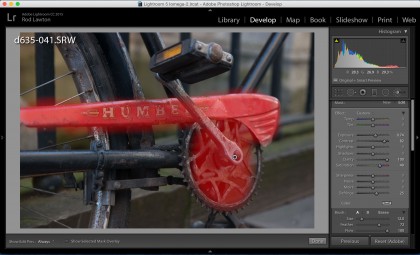
The point about Lightroom’s Adjustment Brush is that all these adjustments are non-destructive. You can go back at any time to add to the mask, erase parts of it, tidy up edges and so on.
Once the mask is created, you can adjust the Exposure, Contrast, Highlights and Shadows, Clarity and more, and these adjustments are non-destructive and permanently editable too.
Lightroom is less sophisticated and powerful than Photoshop in a host of different ways, yet in others it offers a fresh and clever approach that you kind of wish you could use in Photoshop. (Actually, you can – you’ll find the same tools in Adobe Camera Raw and the ACR filter, but not in the main interface.)
Face detection and collection filtering
It’s a little odd to find face detection and recognition tools in a professional image cataloguing application, but maybe Adobe wants to broaden Lightroom’s appeal into the amateur market too. It is a great way to bring together all the pictures you have of your friends and family, and it ‘learns’ as it goes along so that its face recognition becomes more reliable.
At first, Lightroom can still identify unique faces and group them together, but you have to tell it who these people are. The more you use it, though, the more it’s able to suggest names automatically based on identifications you’ve made in the past.
Given that this is the first time Adobe has included face recognition in Lightroom, it feels like the finished article straight away – even if you’re not a big fan of face recognition, you can’t help but be impressed by how straightforward the Lightroom system is.



You can search your entire library for faces, but it’s not a particularly fast process, so it’s best to start small. If you come back from a holiday or trip with a few hundred pictures, you can open the Folder or Collection they’re stored in, then click the new ‘People’ button at the bottom of the Lightroom grid view. It then starts scanning all your pictures for faces.
This is likely to take several minutes, but you can start identifying people while it’s still working. In People mode, the grid view is split into two panels. The top panel contains ‘Named’ people, while the bottom panel displays ‘Unnamed people’. You type a name into the box below a person’s face in the lower panel, and it moves to the one above.
This doesn’t take as long as it sounds because Lightroom is quite smart. It groups similar-looking photos right from the start, displaying them as a single thumbnail image, so you only have to add a name to the group, not every photo within it.
And, as you add more and more pictures to the ‘Named’ panel, Lightroom gets smarter at recognising the same people in the ‘Unnamed’ panel, so that by the time you get to them you only have to agree with Lightroom’s suggestion – or, if necessary, type in a different name.
No face recognition system is perfect, and sometimes Lightroom will pull out sections of an image that aren’t faces at all. All you have to do here is click the ‘X’ box to remove them.
Lightroom tags pictures of people by adding the names you’ve typed in as keywords, so it’s a simple matter to find them later on by searching your library – or you could set up a Smart Collection with that keyword.
Collection filtering
Face recognition isn’t going to be top of everyone’s list, even though it’s touted as one of the main new features in Lightroom 6. But there’s another feature – also connected with searching – that’s much more important but only given a minor mention.
It’s called ‘Collection Filtering’, and it’s a new search box at the top of the Collections panel that lets you type in a name or a search string to find Collections with those words in the title.

This doesn’t sound like a big deal – unless you have a large Lightroom library with tens of thousands of images and, potentially, hundreds of named Collections. The larger your library, the more Collections you’ll create, and the harder it will become to find the one you want in a giant, scrolling list.
You know you’ve got a Collection called ‘Las Vegas at Night’, for example, but where is it? It may not even be visible at all if you’re in the habit of using Collection Sets and keeping them collapsed to save space. But now, if you start typing that Collection title into the new Collection Filtering box, it’ll find your Collection even before you’ve finished the second word (probably).
Or, if you like shooting black and white, and always include ‘black and white’ in the Collection title, this will find all your black and white Collections in just a couple of moments by typing this into the Collection Filter box. For photographers who rely heavily on Lightroom Collections for organizing their photos, this is a massive improvement.
Any Aperture fans reading this will be grinning through gritted teeth at this point. This is something that Apple’s own professional image cataloguing tool (now controversially dropped) did already.
Slideshows, galleries and more
There are a number of other significant improvements in Lightroom 6, some of which are more obvious (and useful!) than others.
For example, the Crop tool has a new ‘Auto’ button that uses some of the clever image-analysing ‘Upright’ tools in the Lens Correction panel. If you click the Auto button, Lightroom will straighten skewed horizons automatically by rotating the crop marquee. This saves time and effort trying to straighten images manually, and it’s reliable too – it correctly straightens a skewed photo almost every time.
Also new in Lightroom 6 is a CMYK soft-proofing option. ‘Soft-proofing’ enables you to check how your images will appear on different output devices in case you need to adjust the colours and contrast to suit them. The CMYK option is important because this is the process used for commercial printing, and there’s often a marked colour shift in the transition from RGB images (what the camera shoots and what you see on the screen) and the CMYK images that the printers need.
Adobe has also introduced a new pet-eye correction tool – it’s like regular red-eye correction for human subjects, but modified to allow for the different colours of animal eyes. This seems distinctly out of place in a program designed for professionals and advanced amateurs, but here it is anyway.
New slideshows and web galleries
More importantly, Adobe has made some big changes to its Slideshow module. Not everyone will use the slideshow tools, but professional photographers who want to create a multimedia portfolio, for example, will find they have a lot more power at their fingertips.


For a start, you now have a choice between slideshows that play back automatically or ones that offer manual control – you might choose this if you want to talk people through your slideshow, for example.
There’s a new Pan and Zoom slider to add motion to your still images (you can include video clips too), and the ability to add more than one background music track – handy if you want to show a longer presentation with lots of slides. Tracks you’ve added are shown as a list in the Music panel, together with their individual duration and the total time. You can drag tracks up and down the list to change the order.
There are two ways to synchronise your audio with your slides. One is to use the ‘Fit to Music’ button – this automatically adjusts the duration of each slide to match the total length of the audio tracks – you can still adjust the length of the Crossfade between slides.
The other is to synchronise the slide transitions with the beat of the music – a clever idea – though you’ll now need to manually match up the total slide duration time with the total audio time, which could prove trickier.
Finally, Adobe has added HTML5 galleries to its web templates as an up to date alternative to Adobe Flash, which is steadily falling out of favour. There are three new gallery templates: Grid Gallery, Square Gallery and Track Gallery.



The Grid Gallery is the most straightforward, displaying images as small thumbnails against a plain background. When you click on a thumbnail it opens a larger version of the photo and you can then use left/right arrows to cycle through the rest.
The Square Gallery works in a similar way except that thumbnails are displayed as a grid of square images with no gaps in between.
The Track Gallery displays thumbnails in rows – all the thumbnails are the same height and vertical images are simply reduced in size to be the same height as horizontal ones.
Web Galleries created in Lightroom can be saved as permanent collections within your library and they can be exported and published online in one of two ways: you can export them wholesale to a folder on your computer and then use an FTP client to upload them to your web server, or you can enter your FTP server’s login details in Lightroom itself and leave Lightroom to look after the FTP transfer. If you have your own web server, publishing web galleries with Lightroom could hardly be simpler.
Verdict
Lightroom CC brings a whole series of improvements over Lightroom 5, but it represents steady development, not a giant leap forward. Is it worth upgrading? If you own Lightroom 5 on a perpetual licence, it will cost you £59/US$79/AU$99 to step up to Lightroom 6, so it’s a close call – we probably would, but others might not.
But if you’re already in the Adobe Photography Plan, it won’t cost you a cent – the Lightroom CC upgrade is all part of the service.


So although many users will be relieved that Lightroom 6 will still be available on a regular perpetual licence, it’s getting harder and harder to find an economic argument against swapping to Adobe’s subscription service. You have to remember that you’re not just getting Lightroom but all the Creative Cloud ancillary services too, such as the ability to synchronise Collections with the Lightroom app on your tablet, and showing the same Collections as online web galleries that others can view.
Adobe says that Lightroom 6/CC also runs faster than its predecessor, though any improvements weren’t obvious in our tests.
We timed both versions while carryout out a set of routine tasks and the results were inconclusive. Lightroom 6 was a couple of seconds slower to launch, but it was a fresh installation so it was probably still caching library files. It did seem to be around 10% faster at importing a folder of images (600, in both JPEG and raw formats), but slower at rendering previews (Standard and Smart). It was around 15% faster at exporting 10 images as full-resolution JPEGs, though.
Lightroom 6 can now use your computer’s GPU (Graphics Processing Unit), though apparently this has most effect when carrying out processor-intensive editing tasks. This proved difficult to test because editing effects in Lightroom are typically quick to render anyway, so perhaps some more investigation is need to find some particularly taxing processes.
We liked
Lightroom very nearly gives you the best of everything. It’s a fast and powerful image organising and cataloguing tool which can also print images, turn them into slideshows and publish web galleries straight to your web server. Its editing tools just get more and more powerful with each version, and each time they do it reduces the time you need to spend in programs like Photoshop – in fact, you can find yourself processing, enhancing and finishing whole folders full of images entirely within Lightroom.

While there’s still resistance amongst some users to the idea of subscription-based software, the price you pay for the Photography Plan gets you Lightroom CC and Photoshop CC and free updates to both in the future.
We disliked
Lightroom still has some quirks which you might not notice if this is your first full-power image cataloguing tool, but if you’re an Aperture user on a Mac who’s been forced to migrate to Lightroom, there will be a few things which grate.
One of these is the way that Folders and Collections are entirely separate. It’s like having two parallel but separate filing systems. If you pick out some pictures within a folder to make a Collection, that Collection appears in an entirely separate panel.


Another is Lightroom’s stacking system. You can group related images together, such as shots taken in a sequence, for example, or different edits of the same image, but that grouping only exists within the Folder or Collection you created it in. If you look at the same photo in a different collection, it’s not grouped with those same images, but could be ungrouped, or grouped with a different set of images. Lightroom’s grouping feature can be useful, but it would be more useful still if it was consistent across your whole library.
Verdict
It’s not difficult to find reasons for recommending Lightroom – in fact, it’s hard to find reasons not to. If you’re a photography enthusiast, expert or professional you need software which can organise, output and enhance your pictures and, with a few minor quibbles and gripes, Lightroom does that perfectly.
It’s true that you’ll still need a full-blown editor for more complex tasks involving layers, masks and complex image-manipulation processes, but if you subscribe to Adobe’s Photography Plan you get that too, in the form of Photoshop CC. In fact, Lightroom and Photoshop work so well together that it’s as if they were designed that way.
You don’t have to use Photoshop with Lightroom. You can configure any other image-editing program to work as an external editor in just the same way. And all the top plug-in makers now produce Lightroom versions of their tools, so you can use them directly without having to switch to Photoshop first.
So do you choose Lightroom 6, the one-off perpetual licence version, for £104/US$149/AU$176, or opt for the subscription-based Lightroom CC + Photoshop CC Adobe Photography Plan at £102/US$120/AU$120? You may not like the idea of subscriptions, but if you go for the perpetual licence then in a year, or two years, when a new version of Lightroom comes out, you’ll have to pay for the upgrade, when Creative Cloud subscribers will get it for nothing.
![]()
Related Posts
December 6, 2021
7+ Web Design Trends for 2022: Which Will You Use?
December 6, 2021
The 10 Best WordPress Booking Plugins to Use On Your Website
December 6, 2021
How to Use a Web Cache Viewer to View a Cached Page
November 6, 2021
10 Modern Web Design Trends for 2022
November 6, 2021
Best Free SSL Certificate Providers (+ How to Get Started)
November 6, 2021
How to Design a Landing Page That Sends Conversions Skyrocketing
November 6, 2021
What Are the Best WordPress Security Plugins for your Website?
October 6, 2021
Your Guide to How to Buy a Domain Name
October 6, 2021
How to Build a WordPress Website: 9 Steps to Build Your Site
September 6, 2021
10 Best Websites for Downloading Free PSD Files
September 6, 2021
HTML5 Template: A Basic Code Template to Start Your Next Project
September 6, 2021
How Much Does It Cost to Build a Website for a Small Business?
September 6, 2021
A List of Free Public CDNs for Web Developers
September 6, 2021
6 Advanced JavaScript Concepts You Should Know
August 6, 2021
10 Simple Tips for Launching a Website
August 6, 2021
25 Beautiful Examples of “Coming Soon” Pages
August 6, 2021
10 Useful Responsive Design Testing Tools
August 6, 2021
Best-Converting Shopify Themes: 4 Best Shopify Themes
July 6, 2021
What Is Alt Text and Why Should You Use It?
July 6, 2021
24 Must-Know Graphic Design Terms
June 6, 2021
How to Design a Product Page: 6 Pro Design Tips
April 6, 2021
A Beginner’s Guide to Competitor Website Analysis
April 6, 2021
6 BigCommerce Design Tips For Big Ecommerce Results
April 6, 2021
Is WordPress Good for Ecommerce? [Pros and Cons]
March 6, 2021
Make Websites Mobile-Friendly: 5 Astounding Tips
March 6, 2021
Shopify vs. Magento: Which Platform Should I Use?
March 6, 2021
Top 5 Web Design Tools & Software Applications
February 6, 2021
Website Optimization Checklist: Your Go-To Guide to SEO
February 6, 2021
5 UX Design Trends to Dazzle Users in 2021
February 6, 2021
What Is the Average Page Load Time and How Can You Do Better?
February 6, 2021
Choosing an Ecommerce Platform That Will Wow Customers
February 6, 2021
7 Best Practices for Crafting Landing Pages with Forms
February 6, 2021
7 B2B Web Design Tips to Craft an Eye-Catching Website
January 6, 2021
Mobile-Friendly Checker | Check Your Site’s Mobile Score Now
January 6, 2021
8 Tips for Developing a Fantastic Mobile-Friendly Website
December 6, 2020
How to Add an Online Store to Your Website [4 Ways]
December 6, 2020
5 UX Design Tips for Seamless Online Shopping
November 6, 2020
Ecommerce Website Essentials: Does Your Site Have All 11?
November 6, 2020
5 Small Business Website Essentials You Need for Your Site
November 6, 2020
Your Website Redesign Checklist for 2020: 7 Steps for Success
May 1, 2020
Psychology of Color [Infographic]
April 21, 2020
How to start an online store that drives huge sales
January 3, 2020
5 Lead Generation Website Design Best Practices
March 6, 2019
6 Reasons You Should Redesign Your Website in 2019
March 6, 2019
7 Web Design Trends for 2019
February 19, 2019
Who owns the website/app source code, client or developer
February 7, 2019
Don’t Let Your Domain Names Expire in 2019
January 8, 2019
2019 Website Development Trends To Note
October 6, 2017
How Web Design Impacts Content Marketing
October 6, 2017
How to Choose a Navigation Setup
August 6, 2017
Why User Experience Matters to Marketing
July 6, 2017
5 Ways Web Design Impacts Customer Experience
September 6, 2016
How to Learn Angular
September 6, 2016
The Excuses for Not Having a Website (Infographic)
September 6, 2016
How to Build an Award-Winning Web Design Team
September 6, 2016
13 Free Data Visualization Tools
August 6, 2016
How Selling Pastries Helped Us Design a Better Product
August 6, 2016
11 Sites to Help You Find Material Design Inspiration
July 4, 2016
How to change free wordpress.com url
April 6, 2016
The 5 Best Free FTP Clients
April 6, 2016
7 Free UX E-Books Worth Reading
March 6, 2016
Can Handwritten Letters Get You More Clients?
December 10, 2015
Star Wars Week: How to create your own Star Wars effects for free
December 6, 2015
20 "Coming Soon" Pages for Inspiration
December 6, 2015
6 Free Tools for Creating Your Own Icon Font
December 6, 2015
9 Useful Tools for Creating Material Design Color Palettes
November 6, 2015
20 Free UI Kits to Download
November 6, 2015
50 Web Designs with Awesome Typography
November 6, 2015
When to Use rel="nofollow"
November 6, 2015
7 Free Books That Will Help You Become More Productive
November 6, 2015
50 Beautiful One-Page Websites for Inspiration
November 6, 2015
Circular Images with CSS
October 6, 2015
Lessons Learned from an Unsuccessful Kickstarter
October 6, 2015
5 Games That Teach You How to Code
October 6, 2015
Cheatsheet: Photoshop Keyboard Shortcuts
October 6, 2015
An Easy Way to Create a Freelance Contract for Your Projects
October 6, 2015
50 Design Agency Websites for Inspiration
September 29, 2015
JB Hi-Fi shutting the book on ebooks
September 24, 2015
Opinion: Quick, Quickflix: It's time to give yourself the flick
September 24, 2015
New Star Wars 360-degree video is among first on Facebook
September 21, 2015
Apple purges malicious iPhone and iPad apps from App Store
September 12, 2015
Apple's new Live Photos feature will eat up your storage
September 12, 2015
The latest Windows 10 Mobile preview has been delayed
September 12, 2015
IBM buys StrongLoop to add Node.js development to its cloud
September 8, 2015
Fake Android porn app takes your photo, then holds it ransom
September 6, 2015
50 Restaurant Websites for Inspiration
September 6, 2015
Zero UI — The Future of Interfaces
September 6, 2015
50 Beautiful Websites with Big Background Images
September 6, 2015
Infographic: 69 Web Design Tips
September 6, 2015
Free Windows 10 Icons
September 2, 2015
Instagram turns itself into a genuine messaging service
August 11, 2015
In Depth: How Microsoft taught Cortana to be more human
August 11, 2015
Windows 10 price, news and features
August 11, 2015
Windows 10's broken update introduces endless reboot loop
August 11, 2015
Windows 10 races to 27m installs
August 11, 2015
Windows 10 IoT Core gets first public release
August 10, 2015
iOS Tips: How to backup iPhone to an external drive
August 10, 2015
Windows 8.1 RT finally getting Windows 10 Start Menu
August 10, 2015
How to use Windows Hello
August 10, 2015
Review: Moto Surround
August 10, 2015
Review: Moto G (2015)
August 9, 2015
8 of the best free VPN services
August 8, 2015
Use Firefox? Mozilla urges you update ASAP
August 7, 2015
Mac Tips: Apple Mail: How to remove the Favorites Bar
August 7, 2015
How to make the OS X dock appear faster
August 7, 2015
Review: BQ Aquaris E45 Ubuntu Edition
August 7, 2015
Review: Acer Liquid Jade Z
August 6, 2015
How to reinstall Linux
August 6, 2015
How to reinstall Windows
August 6, 2015
Updated: Apple Music: release date, price and features
August 6, 2015
Social News Websites for Front-End Developers
August 6, 2015
10 Free JavaScript Books
August 6, 2015
50 Beautiful Blog Designs
August 6, 2015
Animated SVG Pipes Effect
August 6, 2015
Launching Your First App
August 5, 2015
Windows 10 goes freemium with paid apps
August 5, 2015
Updated: Week 1 with Windows 10
August 5, 2015
Mac Tips: How to manage Safari notifications on Mac
August 5, 2015
Microsoft Sway may kill the PowerPoint presentation
August 4, 2015
Microsoft gives Outlook on the web a new look
August 4, 2015
Mac OS X vulnerable to new zero-day attack
August 4, 2015
Windows 10 users warned of two scams
August 4, 2015
Microsoft's Docs.com is now available to everyone
August 3, 2015
Mac Tips: How to edit the Favorites sidebar on Mac
August 3, 2015
Updated: Windows 10 price, news and features
July 29, 2015
Review: HP ProDesk 405 G2
July 29, 2015
Hands-on review: HP Elite x2 1011
July 29, 2015
Hands-on review: Updated: Windows 10 Mobile
July 29, 2015
Review: Updated: Nvidia Shield Android TV
July 28, 2015
LIVE: Windows 10 launch: Live Blog!
July 28, 2015
How to prepare for your upgrade to Windows 10
July 28, 2015
Review: Updated: Windows 10
July 28, 2015
Review: Updated: HP Pro Tablet 608
July 28, 2015
Review: Heat Genius
July 28, 2015
Hands-on review: Moto X Play
July 28, 2015
Hands-on review: Moto X Style
July 28, 2015
Hands-on review: Moto G (2015)
July 28, 2015
Review: 13-inch MacBook Air (early 2015)
July 28, 2015
Hands-on review: OnePlus 2
July 28, 2015
Review: LG 65EG960T 4K OLED
July 28, 2015
Mac Tips: How to share printers on Mac
July 27, 2015
Apple Music's arrival hasn't opened Pandora's box
July 26, 2015
Review: Garmin Swim
July 25, 2015
How to merge OS X contacts into an existing list
July 25, 2015
Hands-on review: UPDATED: ZTE Axon
July 24, 2015
Mac Tips: How to zoom in on a Mac
July 24, 2015
What Windows 10 means for the enterprise
July 24, 2015
Review: JBL Charge 2 Plus
July 24, 2015
Review: Acer Aspire S7
July 24, 2015
Review: Updated: Canon G3 X
July 24, 2015
Review: Updated: iPad Air 2
July 24, 2015
Review: Thinksound On1
July 24, 2015
Review: Asus Chromebook Flip
July 24, 2015
Review: Garmin Forerunner 225
July 23, 2015
Review: Garmin nuvi 68LM
July 23, 2015
Review: Samsung Galaxy S6 Active
July 23, 2015
Review: Bowers and Wilkins P5 Wireless
July 23, 2015
Review: Dell XPS 15 (2015)
July 21, 2015
Review: Fuji S9900W
July 21, 2015
Review: Updated: Fitbit Surge
July 21, 2015
Review: UE Roll
July 21, 2015
Hands-on review: Ubik Uno
July 20, 2015
Review: Samsung HW-J650
July 20, 2015
Updated: 40 best Android Wear smartwatch apps 2015
July 20, 2015
Review: Acer Chromebook C740 review
July 20, 2015
Review: Huawei Talkband B2
July 20, 2015
Review: Dell Venue 10 7000
July 20, 2015
Review: Intel Core i7-5775C
July 17, 2015
Mac Tips: How to delete locked files on Mac
July 17, 2015
Review: Pebble Time
July 16, 2015
Microsoft just made Windows XP even less secure
July 16, 2015
Windows 8.1 RT is getting an update this September
July 16, 2015
OS showdown: Windows 10 vs Windows 8.1 vs Windows 7
July 16, 2015
Review: Acer CB280HK
July 15, 2015
Windows 10 is ready for new laptops and PCs
July 15, 2015
Explained: How to take a screenshot in Windows
July 15, 2015
Office for Windows 10 appears in latest build
July 14, 2015
Review: ZTE Axon
July 14, 2015
Review: ViewSonic VP2780-4K
July 14, 2015
Hands-on review: SanDisk Connect Wireless Stick
July 14, 2015
Review: Oppo PM-3
July 14, 2015
Review: BT 11ac Dual-Band Wi-Fi Extender 1200
July 14, 2015
Review: Fuji X-T10
July 13, 2015
How to build an SEO strategy for your business
July 13, 2015
Review: Lenovo ThinkPad Yoga 15
July 13, 2015
Review: Audio-Technica ATH-MSR7
July 13, 2015
Review: Garmin NuviCam LMT-D
July 13, 2015
Review: Dell Inspiron 13 7000
July 13, 2015
Hands-on review: AstroPi SenseHAT
July 13, 2015
Hands-on review: EE Rook
July 13, 2015
Hands-on review: Updated: HTC Vive
July 12, 2015
Here's the ultimate software list for PC fanatics
July 10, 2015
How to use the new Photos app for Mac
July 10, 2015
Windows 10 Insider Preview Build 10166 available now
July 10, 2015
Splunk spends big on cybersecurity acquisition
July 10, 2015
Making Windows 10 apps just got a whole lot easier
July 10, 2015
Review: Lenovo LaVie Z 360
July 9, 2015
OS X El Capitan public beta available right now
July 9, 2015
Microsoft finally unveils Office 2016 for Mac
July 9, 2015
Review: Updated: Chromecast
July 9, 2015
Review: Updated: Tesco Hudl 2
July 9, 2015
Review: Lenovo ThinkPad E550
July 9, 2015
Review: Updated: Google Nexus 6
July 8, 2015
What you need to know about Windows Server 2016
July 7, 2015
Microsoft to hike enterprise cloud pricing
July 6, 2015
Hacking Team end up being totally 0wned
July 6, 2015
Review: HP Pro Slate 12
July 6, 2015
Review: Samsung 850 Pro 2TB
July 6, 2015
Review: Asus RT-AC87U
July 6, 2015
Review: Jawbone UP2
July 6, 2015
Reimagining the Web Design Process
July 6, 2015
50 Clean Websites for Inspiration
July 6, 2015
15 Free Books for People Who Code
July 6, 2015
Web Storage: A Primer
July 6, 2015
A Look at Some CSS Methodologies
July 3, 2015
6 Essential Mac Mouse and Trackpad Tips
July 2, 2015
How to install a third party keyboard on Android
July 2, 2015
Review: UPDATED: Asus Zenfone 2
July 2, 2015
Review: Alienware 13
July 2, 2015
Review: HP DeskJet 1010
July 1, 2015
5 issues we want Apple Music to fix
June 13, 2015
Cortana will get its own button on Windows 10 PCs
June 12, 2015
Windows 10 will come with universal Skype app
June 12, 2015
iPad music production: 18 Best apps and gear
June 12, 2015
Windows 10 all set for early enterprise struggle
June 12, 2015
Review: Garmin VIRB Elite
June 11, 2015
Review: Updated: Nvidia Shield Tablet
June 11, 2015
Review: Nokia Lumia 635
June 10, 2015
Microsoft brings more online tweaks to Office 365
June 10, 2015
Mac Tips: How to use Screen Sharing in Mac OS X
June 9, 2015
Hands-on review: Meizu M2 Note
June 9, 2015
Hands-on review: EE 4GEE Action Camera
June 9, 2015
Review: Toshiba 3TB Canvio external hard drive
June 9, 2015
Review: Olympus SH-2
June 8, 2015
Hands-on review: Updated: Apple CarPlay
June 8, 2015
UPDATED: iOS 9 release date, features and news
June 8, 2015
Review: Updated: Roku 2
June 8, 2015
Review: Updated: PlayStation Vue
June 8, 2015
Review: Dell PowerEdge R730
June 8, 2015
Review: Canon SX710 HS
June 7, 2015
UPDATED: iOS 9 release date, features and rumors
June 7, 2015
Review: Lenovo S20-30
June 6, 2015
Free Writing Icons
June 6, 2015
15 CSS Questions to Test Your Knowledge
June 6, 2015
The Best CSS Reset Stylesheets
June 6, 2015
How CSS Specificity Works
June 5, 2015
'Delay' is a new feature in Windows 10
June 5, 2015
Review: Beyerdynamic Custom One Pro Plus
June 5, 2015
Latest SEO Marketing tools
June 5, 2015
Review: Nvidia Shield Android TV
June 5, 2015
Review: Honor 4X
June 5, 2015
Review: In Depth: Oppo R5
June 3, 2015
Hands-on review: Huawei P8 Lite
June 3, 2015
How To: How to create eBooks on a Mac
June 3, 2015
Review: Updated: Tidal
June 3, 2015
Review: Canon 750D (Rebel T6i)
June 2, 2015
Review: Updated: Asus ZenWatch
June 2, 2015
Review: Alcatel OneTouch Idol 3
June 2, 2015
Review: Updated: Nokia Lumia 1520
June 2, 2015
Review: Updated: Yotaphone 2
June 2, 2015
Review: Updated: Nokia Lumia 625
June 2, 2015
Review: Creative Muvo Mini
June 1, 2015
Review: Acer TravelMate P645 (2015)
June 1, 2015
Hands-on review: Corsair Bulldog
May 29, 2015
In Depth: NetApp: a requiem
May 29, 2015
July is looking definite for Windows 10 release
May 29, 2015
Hands-on review: Google Photos
May 28, 2015
Mac Tips: The 16 best free GarageBand plugins
May 28, 2015
Review: Canon 760D (Rebel T6s)
May 27, 2015
Review: Lenovo Yoga 3 14
May 27, 2015
Hands-on review: Serif Affinity Photo
May 27, 2015
Review: Garmin Vivoactive
May 26, 2015
Review: Datacolor Spyder5 Elite
May 26, 2015
Hands-on review: Sony Xperia Z3+
May 26, 2015
Review: Epson BrightLink Pro 1410Wi
May 26, 2015
Review: Technics Premium C700
May 26, 2015
Review: Canon EOS M3
May 26, 2015
Review: Updated: HTC One M9
May 26, 2015
Review: Updated: Sony Xperia Z3 Compact
May 25, 2015
Review: Updated: New Nintendo 3DS
May 25, 2015
Updated: 50 best Mac tips, tricks and timesavers
May 25, 2015
Updated: Windows email: 5 best free clients
May 25, 2015
Instagram is planning to invade your inbox
May 25, 2015
Review: Updated: Foxtel Play
May 24, 2015
How Windows 10 will change smartphones forever
May 24, 2015
Review: Vodafone Smart Prime 6
May 24, 2015
Review: Updated: iPad mini
May 22, 2015
Office Now may be Cortana for your work life
May 22, 2015
Review: Updated: Lenovo Yoga 3 Pro
May 22, 2015
Review: Microsoft Lumia 640 LTE
May 22, 2015
Review: Updated: Fitbit Flex
May 21, 2015
Updated: Best free Android apps 2015
May 21, 2015
Review: Asus ZenBook Pro UX501
May 21, 2015
Review: Sennheiser Momentum In-Ear
May 20, 2015
Hands-on review: UPDATED: Asus Zenfone 2
May 20, 2015
OS X 10.11 release date, features and rumors
May 18, 2015
Updated: Best free antivirus software 2015
May 18, 2015
iPhone 6S rumored to launch as soon as August
May 18, 2015
Microsoft ready to pounce and acquire IFS?
May 17, 2015
5 of the most popular Linux gaming distros
May 16, 2015
Review: Acer Chromebook 15 C910
May 16, 2015
Review: Lenovo ThinkPad X1 Carbon (2015)
May 16, 2015
Review: Polk Nue Voe
May 16, 2015
The top 10 data breaches of the past 12 months
May 16, 2015
Hands-on review: Updated: LG G4
May 16, 2015
Review: Updated: Quickflix
May 16, 2015
Review: LG Watch Urbane
May 16, 2015
Review: Razer Nabu X
May 16, 2015
Hands-on review: Updated: Windows 10
May 16, 2015
Review: UPDATED: Moto X
May 16, 2015
Review: Updated: Moto G (2013)
May 12, 2015
Review: TomTom Go 50
May 12, 2015
Review: Updated: Moto G (2014)
May 12, 2015
Review: Garmin Vivofit 2
May 12, 2015
Review: Asus Transformer Book Flip TP300LA
May 11, 2015
Review: MSI GT80 Titan
May 11, 2015
Review: Monster SuperStar BackFloat
May 9, 2015
Review: Updated: Apple Watch
May 7, 2015
5 million internet users infected by adware
May 7, 2015
Review: Updated: New MacBook 2015
May 6, 2015
Android M will be shown at Google IO 2015
May 6, 2015
Review: Epson WorkForce Pro WF-4630
May 6, 2015
Review: Master & Dynamic MH40
May 6, 2015
How to Use Gulp
May 6, 2015
Getting Started with Command-Line Interfaces
May 6, 2015
What It’s Like to Contribute to WordPress
May 6, 2015
Ultimate Guide to Link Types for Hyperlinks
May 6, 2015
11 Things You Might Not Know About jQuery
May 5, 2015
Hands-on review: Updated: PlayStation Now
May 5, 2015
Review: Lenovo ThinkPad Yoga 12
May 5, 2015
Review: Updated: iPad Air
May 5, 2015
Review: Panasonic SZ10
May 5, 2015
Review: Updated: Fetch TV
May 4, 2015
Review: Cambridge Audio Go V2
May 2, 2015
5 of the most popular Raspberry Pi distros
May 1, 2015
Review: PlayStation Vue
May 1, 2015
Hands-on review: Updated: Microsoft HoloLens
April 30, 2015
Build 2015: Why Windows 10 may not arrive until fall
April 29, 2015
The biggest announcements from Microsoft Build 2015
April 29, 2015
Hands-on review: TomTom Bandit
April 29, 2015
Hands-on review: EE Harrier Mini
April 28, 2015
Review: Samsung NX500
April 28, 2015
Hands-on review: LG G4
April 28, 2015
Review: Patriot Ignite 480GB SSD
April 28, 2015
Hands-on review: EE Harrier
April 28, 2015
Review: Linx 10
April 28, 2015
Review: 1&1 Cloud Server
April 26, 2015
Hands-on review: Acer Iconia One 8
April 25, 2015
How to run Windows on a Mac with Boot Camp
April 24, 2015
Dropbox Notes poised to challenge Google Docs at launch
April 24, 2015
Hands-on review: Acer Aspire E14
April 24, 2015
Hands-on review: UPDATED: Valve Steam Controller
April 24, 2015
Review: Acer Iconia One 7
April 23, 2015
Windows 10 just revived everyone's favorite PC game
April 23, 2015
Google opens up Chromebooks to competitors
April 23, 2015
Here's how Outlook 2016 looks on Windows 10
April 23, 2015
Hands-on review: Updated: Acer Liquid M220
April 23, 2015
Hands-on review: Acer Aspire Switch 10 (2015)
April 23, 2015
Hands-on review: Acer Aspire R 11
April 22, 2015
Review: Alienware 17 (2015)
April 22, 2015
Hands-on review: Updated: HP Pavilion 15 (2015)
April 21, 2015
This is how Windows 10 will arrive on your PC
April 21, 2015
Review: iMac with Retina 5K display
April 21, 2015
Review: Epson XP-420 All-in-One
April 18, 2015
Google Now brings better search to Chrome OS
April 17, 2015
Review: Epson Moverio BT-200
April 17, 2015
Review: Pentax K-S2
April 16, 2015
Updated: Android Lollipop 5.0 update: when can I get it?
April 15, 2015
Hands-on review: Updated: Huawei P8
April 15, 2015
Review: SanDisk Ultra Dual USB Drive 3.0
April 15, 2015
Review: Updated: LG G3
April 15, 2015
Review: Updated: LG G3
April 15, 2015
Review: Crucial BX100 1TB
April 13, 2015
iOS 8.4 beta reveals complete Music app overhaul
April 13, 2015
Linux 4.0: little fanfare for a tiny new release
April 13, 2015
Achievement unlocked: Microsoft gamifies Windows 10
April 13, 2015
Best Android Wear smartwatch apps 2015
April 13, 2015
Review: Acer Aspire R13
April 12, 2015
Review: TP-Link Archer D9
April 10, 2015
Microsoft's new browser arrives for Windows 10 phones
April 10, 2015
Review: LG UltraWide 34UC97
April 9, 2015
Office now integrates with Dropbox on the web
April 9, 2015
Now you can buy video games with Apple Pay
April 9, 2015
Updated: iOS 8 features and updates
April 9, 2015
Microsoft's stripped down Nano Server is on the way
April 8, 2015
Skype Translator gets even more features
April 8, 2015
Windows mail services hit by widespread outages
April 8, 2015
Review: UPDATED: Amazon Echo
April 8, 2015
Hands-on review: Dell Venue 10 7000
April 8, 2015
Review: Updated: OS X 10.10 Yosemite
April 7, 2015
Google's GMeet could kill teleconferencing
April 7, 2015
Is Redstone the first Windows 10 update?
April 7, 2015
Next peek at Windows Server 2016 due next month
April 7, 2015
Review: Acer Aspire Switch 11
April 7, 2015
Review: Adobe Document Cloud
April 6, 2015
Hands-on review: Updated: New MacBook 2015
April 6, 2015
Freebie: 100 Awesome App Icons
April 6, 2015
Six Revisions Quarterly Report #1
April 6, 2015
A Modern Approach to Improving Website Speed
April 6, 2015
Disable Text Selection with CSS
April 4, 2015
Review: Nikon D7200
April 3, 2015
Amazon Prime video now streams to any Android tablet
April 3, 2015
Review: Google Cardboard
April 3, 2015
Review: MSI WS60
April 2, 2015
Chrome users can now run 1.3 million Android apps
April 2, 2015
See Windows 10 Mobile running on an Android handset
April 2, 2015
Review: Mini review: Macphun Noiseless Pro 1.0
April 2, 2015
Review: Intel SSD 750 Series 1.2TB
April 2, 2015
Review: BenQ TreVolo
April 2, 2015
Hands-on review: Nikon 1 J5
April 1, 2015
Microsoft launches Windows 10 music and video apps
April 1, 2015
Review: mini review: Sony XBA-H1
December 19, 2014
Review: CoPilot Premium sat nav app
December 19, 2014








































































































